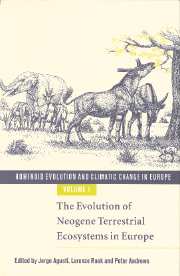Book contents
- Frontmatter
- Contents
- List of contributors
- Acknowledgements: The European Science Foundation
- 1 Introduction
- PART I Palaeogeography of the circum-Mediterranean region
- PART II Miocene mammalian successions
- PART III Palaeoenvironments: non-mammalian evidence
- PART IV Palaeoenvironments: mammalian evidence
- Index
1 - Introduction
Published online by Cambridge University Press: 15 December 2009
- Frontmatter
- Contents
- List of contributors
- Acknowledgements: The European Science Foundation
- 1 Introduction
- PART I Palaeogeography of the circum-Mediterranean region
- PART II Miocene mammalian successions
- PART III Palaeoenvironments: non-mammalian evidence
- PART IV Palaeoenvironments: mammalian evidence
- Index
Summary
The late Neogene (the period between – 14 and – 2.4 Ma) is one of the most interesting phases in understand the present configuration of terrestrial ecosystems. It was during this time that the change took place from the middle Miocene dominant subtropical forests that stretched across southern Europe and western Asia to a more open but still wooded biotope that now prevails in warm–temperate areas. This change in vegetation, which strongly affected the composition of mammalian faunas, seems to be linked to the rapid spread of grasses around 8–10 Ma ago. Moreover, in the late Neogene, climatic shifts and falling temperatures due to the spread of the Antarctic Ice, were followed by the Plio-Pleistocene Arctic glaciations in the Northern Hemisphere. Furthermore, during the late Neogene, important changes at the regional level gave rise to the present configuration of the Old World land masses, and the successive drying of inland seas in the European area facilitated faunal interchange between Europe and Central Asia and Africa. At the same time, other tectonic processes like the Himalayan and the Tibetan uplifts and the opening up of the great eastern African basins and Red Sea, although working in opposite directions, favoured the processes of speciation and isolated evolution.
All these phenomena must have had a strong influence on hominid evolution between 14 and 2 million years ago (Ma). The diversity of hominid species recorded in that period must be considered in relation to the changing environmental conditions and to constrictions imposed by the existence of significant zoogeographical barriers.
- Type
- Chapter
- Information
- Hominoid Evolution and Climatic Change in Europe , pp. 1 - 6Publisher: Cambridge University PressPrint publication year: 1999



